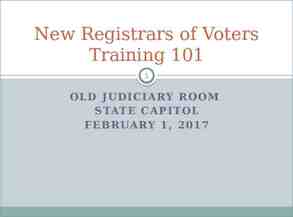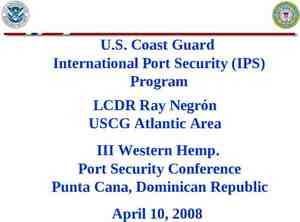California State Parks and Recreation Commission Old Sacramento
9 Slides5.25 MB
California State Parks and Recreation Commission Old Sacramento Business Intelligence Commission Chair: Ernest Chung Presenter: Aaron Robertson Nov 8, 2013
Deep Performance Management Roots Restoring trust and accountability availability of information California State ParksImproving was once recognized Department once known for performance excellence and performance-based budgeting!
Performance Management and Business Intelligence System Restoring trust and accountability Improving availability of information “Parks' decision-making has long depended more on idiosyncrasies' of its managers than on dictates of the data” Former Chief Deputy Director at California State Parks We collect data but we don’t use the data in a systematic way to make decisions Data is constantly in flux, ineffectively governed, and we often employ inconsistent data collection methodologies Disparate systems across the department promote redundancy, contribute to unnecessary costs and result in reduced confidence in quality of our decisions State Parks needs an enterprise wide system to make informed strategic decisions and to achieve better control over day-to-day operations Examples include: Understanding of who visits state parks now and who might use them in the future Need for analysis of customer data to determine or anticipate purchase patterns Park Sustainability Index - revenue to expense ratio
Performance Management and Business Intelligence System Restoring trust and accountability Improving availability of information Executive Dashboard Executive Dashboard (with cascading views) Year-Over-Ye ar Quarterly Comparison Q2 FY 10/11 Q2 FY 11/12 (data current as of 9/22/11) 07/01/2012 - 09/30/2012 Prev ious 12 Months vs Current 12 Months Target P 365 Days 365 Days No Data No Data Year-Over-Ye ar Quarterly Comparison % Change No Data No Data % of Employees w/completed IDP/Performance Appraisals in past y ear Customer (Natural and Cultural Resource P rotection, Education/Interpretation, % Change No Data % of staff who have completed Mandatory Training CalParkStat Concept July 5, 2012 Provide for the health, inspiration and education of the people of California by he lping to prese rve the state's extraordinary biological diversity, protecting its most valued natural and cultural re sources, and creating opportunities for high-quality outdoor recreation. Employee Overall satisfaction of State Parks employees ("Exc", "V Good", "Good" on Survey) No Data Prev ious 12 Months vs Current 12 Months Public Safety, Recreation) Q2 FY 10/11 Q2 FY 11/12 Visitor Attendance % Change No Data Target P 365 Days 365 Days % Change No Data Number or hours of interpretive programs events completed No Data No Data Incidence of Crime (se lect the most relevant crimes here) No Data No Data Rese rvations made No Data No Data % of cancellations No Data No Data Internal Processes (Faciliti es , Acctabi lity, Tra nsparency & Org Exc) Year-Over-Ye ar Quarterly Comparison Q2 FY 10/11 Q2 FY 11/12 Cost of com pleted facility repair actions Prev ious 12 Months vs Current 12 Months Target P 365 Days 365 Days Year-Over-Ye ar Quarterly Comparison Q2 FY 10/11 Q2 FY 11/12 % Change No Data % Change No Data No Data No Data Incidence of Crime (se lect the most relevant crimes here) Financial (Fisca l R espons i bil ity) % Change No Data No Data Park Accidents No Data Prev ious 12 Months vs Current 12 Months Target P 365 Days 365 Days % Change Operating Costs No Data No Data Revenue as % of Operating Costs No Data No Data Average Revenue Per Visitor No Data No Data Revenue No Data Bi-Weekly Reviews of Performance Data review performance trends ask clarifying questions about activity recognize accomplishments work collaboratively to solve problems Integrated Data Cube Administrative Databases Surveys MyCal Pays CalSTARS Info DB (CID) Labor Info Db (LID) FI CAL Operational Databases Park Infrast Db (PID) CAD / RMS Attendance Db Revenue Db Fee Collection System
Key Intelligence Topics Framework Customer & Partner Current Visitor’s Voice Prospective Visitor’s Voice Partner’s Voice Satisfaction Career Development Employee Performance Grants and Loans Employee Internal Process Administrative Efficiencies Natural Resource Protection Cultural Resource Protection Facilities Education / Interpretation Public Safety Fiscal Revenue Operating Costs Self Sufficiency Change (% Revenue vs Expenses) Budget to Actual Comparison Key intelligence topics are the most relevant strategic and operations business topics facing State Parks Recreation
Key Intelligence Topics Cascading Structure Restoring trust and accountability Improving availability of information Visitors Voice Attendance Satisfaction Day Use Day Use - District - District - Sector - Park Unit - Sector - Park Unit Camping Camping - District - District - Sector - Park Unit - Sector - Park Unit Information Needs Rentals Campsite Rentals - District – Nights/Occupancy % - Sector - Nights/Occupancy % - Park Unit - Nights/Occupancy % Cabin Rentals - District – Nights/Occupancy % - Sector - Nights/Occupancy % - Park Unit - Nights/Occupancy %
Screen Sample
Screen Sample District
Next Steps Complete needs assessment Secure funding source Develop and Release RFP / Award Contract Design System Implement system - Technology - Business and management processes














